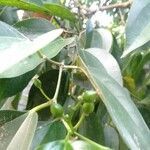Trees to 30 m tall, evergreen. Bark grayish white to grayish brown or gray. Branchlets brown or tan, glabrous or pubescent. Winter buds naked, without differentiated scales. Stipules ovate-lanceolate to ovate, 2-8 mm, glabrous or pubescent, enfolding naked terminal bud, apex attenuate. Petiole glabrous, 0.5-1.5(-2) cm, adaxial furrow deep and narrow or broad and shallow; leaf blade lanceolate-elliptical, ovate-elliptical, or oblong, 4.5-18 × 2.5-11.5 cm, papery to leathery, glabrous or with a scattering of inconspicuous appressed hairs, base acute, obtuse, or rounded, symmetric or weakly asymmetric, margin entire, apex rounded-obtuse to gradually or abruptly acuminate; secondary veins 1 or 2 on each side of midvein. Cymes 1 or 2 per leaf axil, densely flowered, much branched, each with ca. 5 bisexual flowers and 5 or more male flowers. Styles 2, apically broadened and 2-cleft or emarginate. Infructescences 1-3 per leaf axil, stout, branched or unbranched, with 1-3 drupes and prominent scars from fallen flowers, glabrous, 2.5-5 cm, 3-6 × as long as subtending petiole. Drupe orange to red, 0.8-1.4 cm, globose to ellipsoid, base rounded to obtuse, apex rounded to obtuse. Stone ovoid to ± globose, 6-13 mm, conspicuously to inconspicuously ribbed.
Shrub or tree to 15 (–25) m high. Adult leaves: lamina elliptic to suborbicular or ovate to broadly ovate, (1.3–) 4–21 cm long, 0.9–10 cm wide, rounded at base, sometimes oblique, mostly entire (sometimes toothed), acuminate, markedly 3-veined, glabrous to slightly scabrous above, glabrous to sparsely puberulous below; petiole 2–14 mm long; stipules ovate, 6–10 mm long, peltate, caducous. Inflorescence a many-flowered panicle, either male or male and bisexual. Flowers 5-partite. Male flowers: perianth lobes ovate-elliptic, 1.5–2 mm long; stamens 1.5–2.5 mm long; anthers subreniform. Bisexual flowers: perianth lobes ovate-elliptic, 2–2.5 mm long; stamens 1.5–3 mm long; ovary ovoid-cylindrical, 2–2.5 mm long; stigmatic arms 1–1.5 mm long, bilobed or bifid. Drupe ovoid, 7–15 mm long, yellow, orange, pink or red; pedicel 0.3–1.5 cm long. See also Dixon & Kerrigan (2011), Zich et al. (2020). [The above description of Celtis philippensis is adapted from Hewson (1989) but may require further revision to exclude elements of the species Celtis strychnoides which was included as a synonym of C. philippensis at the time of publishing the Flora of Australia Volume 3 treatment-Editor, 23 September 2021.]
A medium sized tree. It grows 4-10 m tall. It often has buttresses. It has a dense rounded crown. The tree can lose many of its leaves during the dry season of the year. The bark is smooth with a mottled cream grey pattern on it. The leaves are alternate and smooth. They are stiff and brittle. They are oval and about 3-12 cm long by 2-6 cm wide. The leaves are dark green above and paler underneath. There are 3 easy to see veins along the leaf. These are raised and white, underneath the leaf. The leaves have a pointed tip and short stalk (1 cm). The young leaves have teeth along the edge. The flowers are small and white and 2-3 mm across. They occur in small clusters (2 cm across) in the axils of leaves. Flowers of one or both sexes can occur on the same plant. The fruit are smooth and fleshy. They are round but flattened. They can be 0.7-1 cm across. They are yellow, but bright red when ripe. They contain a single hard shelled seed. The seed can be 6 mm across.
Leaves (5)6.5–12(17.5) x 2.5–4.5(8) cm., elliptic to elliptic-ovate or elliptic-oblong; apex with a wide (usually short) acumen and mucronate tip; base slightly asymmetrical and broadly cuneate to rounded or subcordate; margin entire or (rarely in Flora Zambesiaca region) coarsely dentate in the upper half; lamina thinly coriaceous, pale green, punctate but smooth and ± shiny above, glabrous; 3-nerved from the base, the basal lateral nerves extending almost to the apex, as strongly prominent beneath as the midrib, upper lateral nerves 1–2(3) on each side of the midrib, rather fine and inconspicuous; secondary venation fairly closely parallel, ± horizontal between the midrib and basal lateral nerves.
Inflorescence in leaf axils towards the ends of branches; lower inflorescences 5–30 mm. long, containing many crowded male (lowers, these sessile or with pedicels to 2 mm. long, and a few female and bisexual flowers at apices of branches of these inflorescences, their pedicels usually longer; upper inflorescences usually short with several bisexual flowers.
Evergreen much-branched tree 5–20 m. tall, monoecious; bole often with short buttresses, bark smooth grey, wood white; young stems and branches very sparsely white-pubescent, glabrescent.
Petiole 4–10(16) mm. long; stipules 3–7 mm. long, lanceolate, shortly produced below the point of attachment, ± pubescent.
Ovary ± glabrous, with a basal ring of long hairs; styles very shortly bifid, (1)1.5–2(3.5) mm. long.
fruits red, 9–12 x 7–10 mm., ovoid, glabrous; pedicels 3–7 mm. long.
Sepals 1.5–2.5 mm. long, pubescent.


